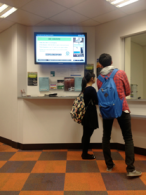It is with great regret that I say farewell to my weekly BCM240 routine of blogging on the topic of media, audience and places; space which may be privately public or publically private. Fear not, loyal followers as I am now an addicted blogger, and have learnt to embrace sharing my personal opinions on the worldwide web and will continue to blog on, in one online form or another.
I relish in my new-found online persona and value my blogging journey. As my confidence level grew, I embarked on sharing my blogs through other social media platforms such as Twitter and Facebook, expanding my readership. By extending my online voice over social media, my follower base increased. Initially, this was not an easy task as I was hesitant to introduce my Facebook friends to scrutinize my academic handiwork but after receiving their positive support, sharing my blogs with friends and family was well-received and ultimately become a successful self-promoting tool.
To facilitate my research and enlighten my understanding of the given themes, I chose to follow my fellow BCM240 student bloggers material, using WordPress and Twitter as a means of gathering information and handy references. These online platforms helped expand my own ideas and opinions regarding media platforms, the audience that use them and the space/places we indulge in our media consumption. My newly discovered understanding and self-confidence encouraged my own discussions but also prompted me to want to share my feedback. I began to comment on fellow bloggers posts, sharing my opinions and reflections regarding their work and viewpoints. This action benefited both parties; as I received a chance to share and comment while the blogger received a critique of his/her work. As a result of sharing my opinions, online researching and posting my feedback, my blog audience grew from being restrictively Australian based to gaining global recognition.
Statistically, my current tally of global readers who visit my BCM240 collection of blogs is nudging 300; not bad for an inexperienced rambler. This positive result confirms that blogging is prevalent and socially accepted justifying why the interest in civil journalism is on the increase. This tally illustrates that anyone; no matter what their background or status, can share their ideas online and have their voice heard!
The media, audience and places course outline presented me personally with a plethora of new ideas and new researching tools by incorporated relative links to develop on my thoughts. BCM240 subjects’ research topics tend to be unique and not well publicized, encouraging me to look outside the obvious Google links. By strategically, searching new website browsers, I was able to acquire relevant data and sources that enhanced my online voice. This term, I have blogged on range of specific topics. I have expanded my knowledge of public screens and all the connotations; negative and positive that come with it, the piracy laws that restrict Australian audiences from being up to date with their favorite TV shows and the power that online media gives the fandom community to stay connected and share their fanatical love.
Overall, my blogging journey and success has been a shared one. I have utilised strategies to increase my audience traffic, I have built relationships with my fellow media students and learnt how one topic can be extended into multiple unique blog posts. The process of blogging for BCM240 has been rewarding and a learning experience as I have found blog posting so different to other forms of academic or creative writing. I believe I have improved my tone and clarity, achieving a professional and formal of writing that is appropriate for a public audience while keeping my wit and sense of fun. By incorporating individual stories and photos of my life, I have established a relationship with my audience on a personal level. I have specifically practiced and taken the time to the structure my blogs so they are both organised and easy to read.
I hope you have enjoyed reading my media, audience and place blogs just as much as I have enjoyed writing them. As you may already know, it is unlike me to go out without a bang, so here we go 🙂
REFERENCES
BonisBoyz 2009, ‘fireworks gone wrong’ youtube video, accessed 26th September 2013, <http://www.youtube.com/watch?v=nckkYeseKSY&feature=fvwrel- >






Recent Comments